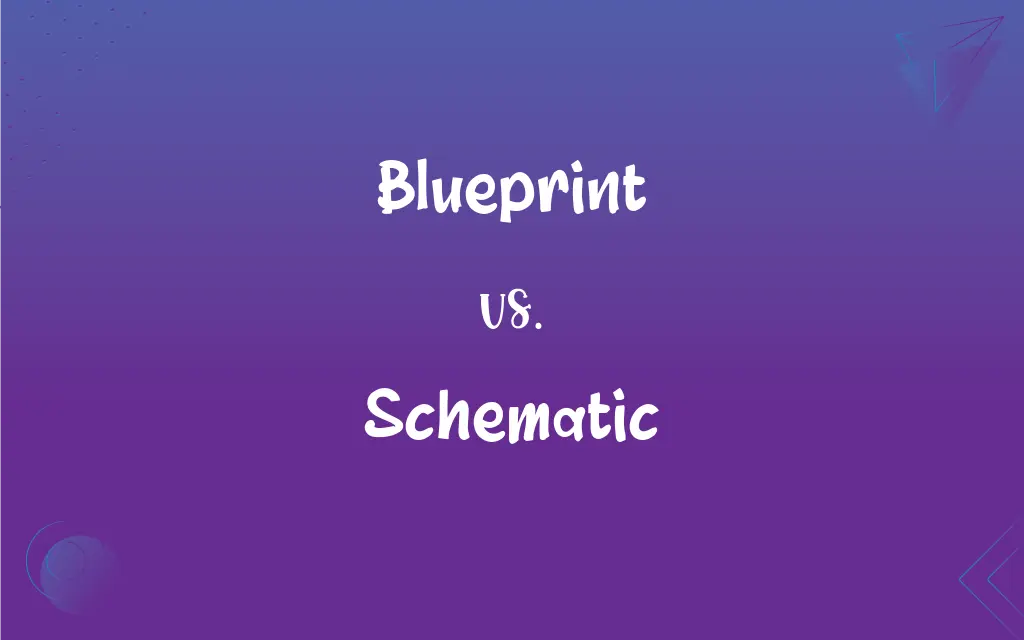Blueprint vs. Schematic: What's the Difference?
Edited by Aimie Carlson || By Janet White || Published on January 15, 2024
Blueprint is a detailed plan or drawing, often in construction, while a schematic is a simplified diagram, mainly for electronic or mechanical systems.

Key Differences
A blueprint is traditionally a detailed architectural or construction drawing, presenting a complete view of a building or structure. It conveys dimensions, materials, and layout. In contrast, a schematic is a simplified representation, primarily used in electronics or mechanics, showing components and connections but not focusing on physical layout or scale.
Blueprints serve as a comprehensive guide for builders, providing exact specifications for construction. Every element, from room sizes to window placements, is precisely detailed. Schematics, however, prioritize function and relationships between components, such as in a circuit diagram, and are less concerned with specific dimensions or physical placement.
In terms of usage, blueprints are fundamental in the construction and architectural industries. They are essential for ensuring accurate and consistent building work. Schematics are indispensable in fields like electrical engineering, where understanding the flow and connections of a system is crucial.
The creation process differs significantly: blueprints require meticulous attention to detail and scale, often created by architects. Schematics are usually drafted by engineers or designers, focusing on abstract representation of circuits or systems rather than precise physical representation.
As tools of communication, blueprints are designed to be understood by a wide range of professionals from architects to builders. Schematics, while still accessible, are more specialized, typically intended for engineers or technicians familiar with the specific symbols and conventions used.
ADVERTISEMENT
Comparison Chart
Definition
Detailed architectural or construction drawing
Simplified diagram for electronic/mechanical systems
Focus
Precise dimensions, materials, layout
Function, relationships between components
Primary Use
Construction, architecture
Electrical, mechanical engineering
Detail Level
High, with exact specifications
Lower, abstract representation
Target Audience
Architects, builders, contractors
Engineers, technicians
ADVERTISEMENT
Blueprint and Schematic Definitions
Blueprint
A detailed technical drawing.
The engineer examined the machine's blueprint carefully.
Schematic
A simplified or abstracted form of a plan.
The designer created a schematic for the new interface.
Blueprint
A guide or model for future development.
The committee's report served as a blueprint for reform.
Schematic
A layout of an electrical or mechanical system.
The technician checked the schematic for troubleshooting.
Blueprint
A detailed plan or drawing for construction.
The architect presented the blueprint for the new library.
Schematic
A symbolic representation, especially in electronics.
The schematic made the complex circuit easier to understand.
Blueprint
A photographic print with white lines on a blue background.
The old factory's blueprints were found in the attic.
Schematic
A plan showing essential features without detail.
The scientist drew a schematic of the experimental setup.
Blueprint
A plan or design strategy.
The marketing blueprint was approved by the team.
Schematic
A diagram that represents elements of a system.
The electrician used a schematic to fix the wiring.
Blueprint
A contact print of a drawing or other image rendered as white lines on a blue background, especially such a print of an architectural plan or technical drawing. Also called cyanotype.
Schematic
Of, relating to, or in the form of a scheme or diagram.
FAQs
Do schematics show physical size?
No, they focus on function, not physical dimensions.
What is a schematic?
A simplified diagram showing components and connections.
Can blueprints be used in manufacturing?
Yes, especially for detailed product design.
Are blueprints still blue?
Traditionally yes, but modern blueprints can be in various colors.
Who creates blueprints?
Architects or draftspersons typically create blueprints.
Are schematics used in architecture?
Rarely, they are more common in electronics or mechanics.
How detailed is a blueprint?
Very detailed, showing exact measurements and materials.
What is a blueprint?
A detailed architectural or construction drawing.
Are schematics useful in troubleshooting?
Yes, they help in understanding system functionalities.
Do blueprints require special training to read?
Basic understanding of drafting and design is needed.
Are blueprints only for new constructions?
No, they can be used for renovations and other projects.
Is a schematic easy to read?
For professionals familiar with the symbols, yes.
Can blueprints be modified easily?
Yes, especially digital versions.
Who uses schematics?
Engineers, technicians, and specialists in relevant fields.
Do schematics include color coding?
Often, to differentiate between various components.
Can blueprints be digital?
Yes, digital blueprints are common in modern design.
What scale are blueprints drawn to?
Various scales, depending on the project's size and detail.
Do schematics represent reality?
They represent functional aspects, not physical reality.
Are schematics standardized?
Yes, especially in fields like electronics.
Can schematics be used for patent applications?
Yes, particularly for illustrating inventions or designs.
About Author
Written by
Janet WhiteJanet White has been an esteemed writer and blogger for Difference Wiki. Holding a Master's degree in Science and Medical Journalism from the prestigious Boston University, she has consistently demonstrated her expertise and passion for her field. When she's not immersed in her work, Janet relishes her time exercising, delving into a good book, and cherishing moments with friends and family.
Edited by
Aimie CarlsonAimie Carlson, holding a master's degree in English literature, is a fervent English language enthusiast. She lends her writing talents to Difference Wiki, a prominent website that specializes in comparisons, offering readers insightful analyses that both captivate and inform.































































